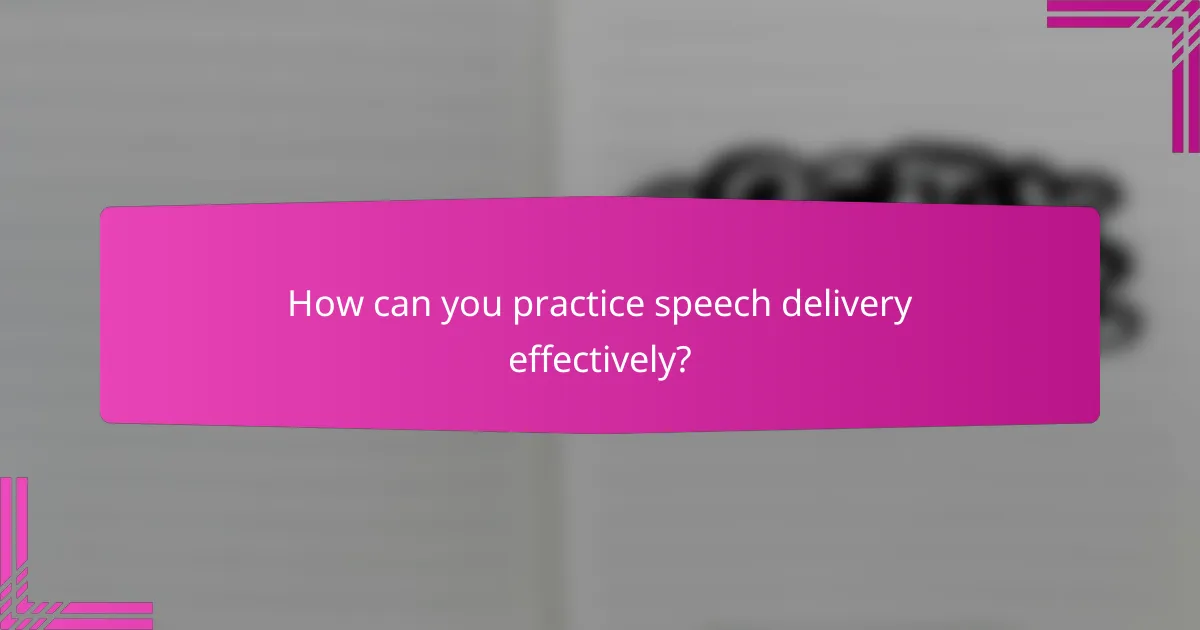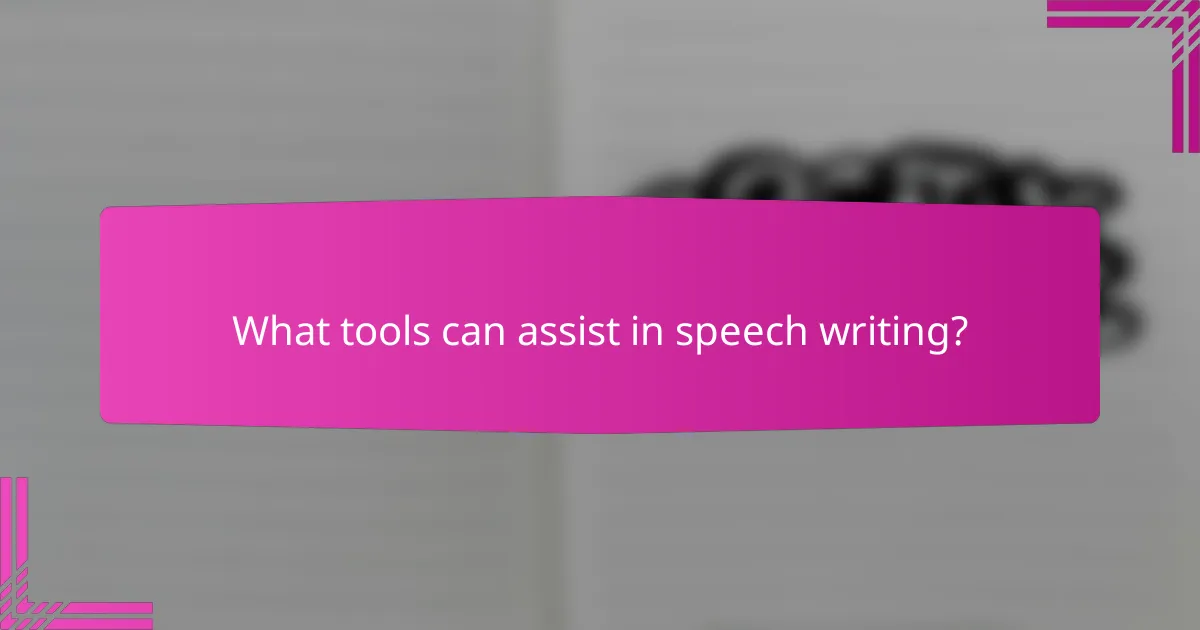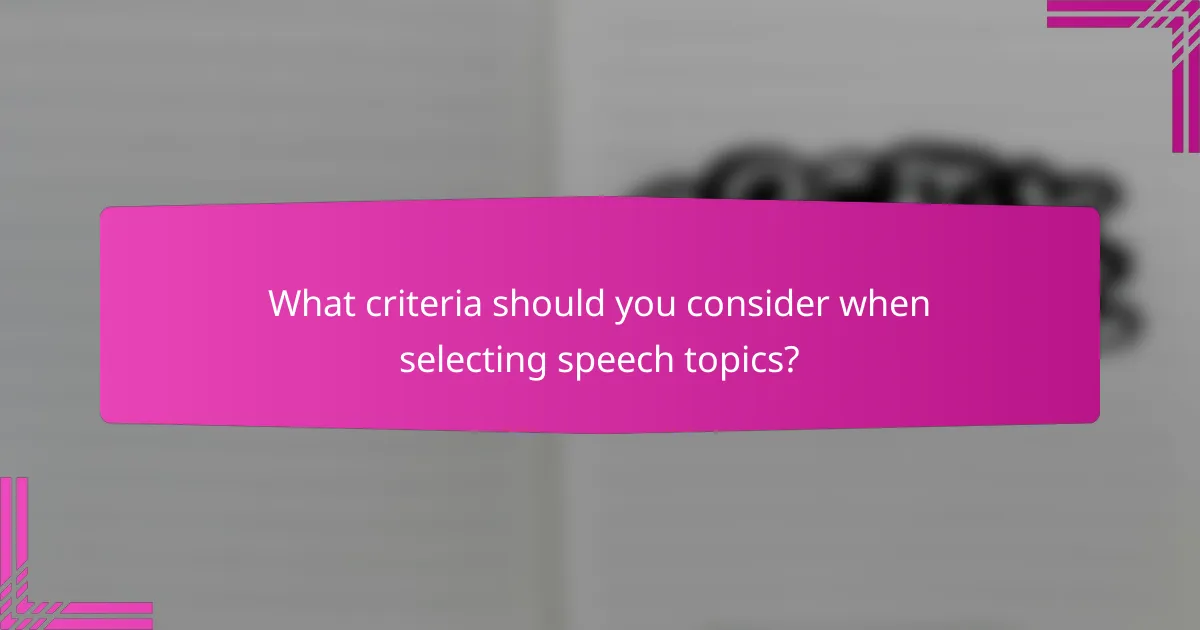Crafting an effective speech begins with thorough audience research, allowing you to tailor your message for maximum engagement. Once you understand your listeners, you can draft a speech that organizes your thoughts clearly and resonates emotionally. Finally, practicing your delivery through various techniques will refine your skills and boost your confidence, ensuring your message is impactful.

How to research your audience for effective speeches?
Researching your audience is crucial for crafting effective speeches that resonate. Understanding who your audience is will help tailor your message to their preferences, ensuring better engagement and impact.
Identify audience demographics
Start by gathering demographic information such as age, gender, education level, and occupation. This data helps you understand the background of your audience, allowing you to adjust your language and examples accordingly.
For instance, a speech aimed at young professionals may use contemporary references and a more casual tone, while a talk for industry veterans might require a more formal approach and specialized terminology.
Analyze audience interests
Investigate what topics and issues resonate with your audience. This can be done through surveys, interviews, or by reviewing relevant publications and forums. Knowing their interests allows you to incorporate relatable anecdotes and examples into your speech.
For example, if your audience is passionate about sustainability, including relevant statistics or case studies can enhance your speech’s relevance and engagement.
Gather feedback from previous events
Review feedback from past speeches or events to identify what worked well and what didn’t. This can provide insights into audience preferences and expectations, helping you refine your approach.
Look for common themes in the feedback, such as preferred topics or delivery styles, and use this information to shape your upcoming speech.
Utilize social media insights
Leverage social media platforms to gauge audience sentiment and interests. Tools like polls, comments, and engagement metrics can reveal what topics are trending and what your audience cares about.
For instance, analyzing comments on your previous posts can highlight specific areas of interest or concern, allowing you to address these points directly in your speech.

What are the best practices for drafting speeches?
Effective speech drafting involves organizing your thoughts clearly, engaging your audience emotionally, and using persuasive language. By following structured practices, you can create impactful speeches that resonate with listeners.
Structure your speech with clear sections
A well-structured speech typically includes an introduction, body, and conclusion. The introduction should grab attention, the body should present key points logically, and the conclusion should summarize and reinforce your message.
Consider using a framework like the “Problem-Solution” or “Chronological” approach to organize your content. This helps the audience follow your argument and retain information more effectively.
Incorporate storytelling techniques
Storytelling can make your speech more relatable and memorable. Use anecdotes or personal experiences to illustrate your points and connect with the audience on an emotional level.
When crafting your story, focus on a clear narrative arc: setting the scene, introducing conflict, and providing a resolution. This structure keeps listeners engaged and enhances the overall impact of your message.
Use persuasive language and rhetoric
Persuasive language employs rhetorical devices such as metaphors, similes, and repetition to strengthen your argument. These techniques can evoke emotions and encourage the audience to agree with your viewpoint.
Incorporate phrases that resonate with your audience’s values and beliefs. For example, using inclusive language can foster a sense of community and shared purpose, making your message more compelling.
Tailor content to audience needs
Understanding your audience is crucial for effective speech drafting. Research their demographics, interests, and knowledge level to ensure your content is relevant and engaging.
Adjust your tone, language, and examples based on the audience’s background. For instance, a speech for industry professionals may include technical jargon, while a community event speech should be more accessible and relatable.

How can you practice speech delivery effectively?
Effective speech delivery practice involves a combination of recording sessions, engaging in mock presentations, seeking feedback, and utilizing visualization techniques. These methods help refine your speaking skills, boost confidence, and enhance overall performance.
Record and review practice sessions
Recording your practice sessions allows you to review your delivery style, pacing, and clarity. Listening to your recordings can help identify areas for improvement, such as filler words or awkward pauses.
Consider using a smartphone or a webcam to capture your practice. Aim to record multiple sessions to track your progress over time. Reviewing these recordings can provide valuable insights into your strengths and weaknesses.
Engage in mock presentations
Mock presentations simulate the actual speaking environment, helping you become comfortable with your material and delivery. Try to present in front of friends, family, or colleagues who can provide a supportive atmosphere.
Set up a realistic setting by using a podium or standing in front of an audience. This practice can help you manage nerves and improve your ability to engage with listeners. Aim for at least two to three mock presentations before the actual event.
Seek constructive feedback from peers
Receiving feedback from peers can provide different perspectives on your speech delivery. Encourage them to focus on both strengths and areas for improvement, such as body language, tone, and content clarity.
Consider creating a feedback form that addresses specific aspects of your presentation. This structured approach can help gather actionable insights and make it easier to implement changes in your delivery.
Utilize visualization techniques
Visualization techniques involve mentally rehearsing your speech and imagining a successful delivery. This practice can enhance your confidence and reduce anxiety before the actual presentation.
Spend a few minutes each day visualizing yourself speaking confidently in front of an audience. Picture the setting, your gestures, and the positive reactions from listeners. This mental practice can significantly improve your performance on the day of the speech.

What tools can assist in speech writing?
Various tools can enhance the speech writing process by streamlining drafting, analyzing audiences, and improving delivery. Utilizing the right software and platforms can significantly elevate the quality and effectiveness of your speeches.
Speech writing software like Scrivener
Speech writing software, such as Scrivener, provides a structured environment for drafting and organizing your content. It allows users to break down speeches into manageable sections, making it easier to focus on individual points while maintaining overall coherence.
Consider features like the ability to create outlines, store research, and integrate notes. These tools help ensure that your speech flows logically and stays on topic, which is crucial for engaging your audience.
Online platforms for audience analysis
Online platforms for audience analysis, such as SurveyMonkey or Google Forms, enable you to gather insights about your audience’s preferences and expectations. Understanding your audience’s demographics, interests, and knowledge levels can help tailor your speech to resonate more effectively.
When using these platforms, consider crafting targeted questions that reveal what your audience values. This data can guide the tone, content, and examples you include in your speech, enhancing its relevance and impact.
Apps for practicing delivery like Orai
Apps like Orai provide valuable tools for practicing speech delivery, offering features such as voice analysis and feedback on pacing, tone, and clarity. These applications can help you refine your delivery style and build confidence before presenting to an audience.
To maximize the benefits of these apps, practice regularly and focus on specific aspects of your delivery, such as reducing filler words or improving articulation. Consistent use can lead to noticeable improvements in your public speaking skills.

What criteria should you consider when selecting speech topics?
When selecting speech topics, consider your audience’s interests, the relevance of the subject, and your own expertise. A well-chosen topic engages listeners and enhances your credibility as a speaker.
Audience Interests
Understanding your audience’s interests is crucial for selecting a compelling speech topic. Research demographics, preferences, and current trends that resonate with your listeners. For instance, a speech for a group of young professionals might focus on career development, while a community event could benefit from discussions on local issues.
Relevance and Timeliness
Choose topics that are relevant and timely to ensure your speech captures attention. Consider current events, emerging technologies, or social movements that may impact your audience. For example, discussing sustainability practices is increasingly relevant as environmental concerns grow globally.
Your Expertise and Passion
Your knowledge and enthusiasm for a topic can significantly enhance your speech’s effectiveness. Select a subject where you have substantial expertise or personal interest, as this will help you convey information confidently and authentically. If you are passionate about mental health, for instance, sharing personal experiences can create a deeper connection with your audience.



